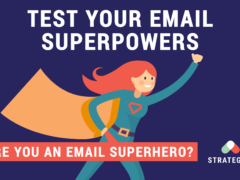Make sure you nail the fundamentals
If you want an email marketing program that really delivers results, you need to get the technical basics right. The most beautiful content won’t drive results if it doesn’t get delivered. According to ReturnPath email deliverability report, an average of 20% of all email messages never reach their audience. Generally because they’re blocked or diverted from the inbox.
Here are the key elements that you need to nail to make sure you don’t get tripped up by some technical glitch. A glitch that will impact your email marketing results.
Email marketing challenge #1:
Getting your data in order
The very first step of any email marketing program is to get access to clean and up to date data. Start with a data schema or list of fields that you’ll need in order to execute your campaign.
Over and above the email address and name, what data do you need in order to personalize your message? Data that will help you make it relevant through accurate targeting. This can include things like the date of the last transaction, or the last interaction, the year of birth, how long a customer has been with you, their total lifetime value, etc. And don’t forget to include the data needed to manage tacit and express consent (see below).
Email marketing challenge #2:
Getting your sending domain authenticated
One of the greatest challenges of any email marketing program is deliverability. This stems in part from the sad reality that 70% of all emails is spam. And that a significant portion of that spam is fraudulent email sent by hackers with malicious intent. This forces service providers and corporate firewalls to be extra careful when handling all inbound email.
One common tactic used by spammers is to impersonate an organization. They do this by falsely using its domain name and email address. This is commonly known as spoofing.
To make this more difficult, three measures are commonly used in order to “authenticate” the sender. Their purpose is to prove that you are who you say you are, and not some cybercriminal trying to commit a crime. These three measures are known by their acronyms SPF, DKIM and DMARC.
The authentication process requires you to modify the domain name services or DNS settings in order to associate your email platform’s IP address to your sending domain. Failure to do this will result in your emails landing in quarantine or being blocked by email servers and ISPs.
New since original publication
New addition to the authentication ecosystem is BIMI (Brand Indicator for Message Identification) a new standard created to make it easier to get your logo displayed next to your message in the inbox. BIMI is a text record that lives on your server’s DNS records. It works right alongside SPF, DMARC, and DKIM to prove to email clients that you are you who you claim to be. It doesn’t work in all email clients yet, but is progressively being rolled out across webmail services starting with Yahoo.
Email marketing challenge #3:
Staying CASL and GDPR compliant
A key priority for your email marketing program is going to compliance. This means ensuring that you’re not breaching the stringent regulations surrounding the Canadian Anti-Spam Legislation in Canada. Your email platform and database must be able to manage two distinct categories of consent. The first is implied consent, which is linked to a purchase by your customers in the last two years. The second is express consent, which is given by customers as a result of filling out an opt-in form of some kind.
In addition to managing consent expiry dates for implied consent, you’ll need to ensure that your form and website copy are also compliant. That’s also the case with your email footers. And you should set up a mechanism that automatically excludes consumers with expired or withdrawn consent from your email campaigns.
And if you do business with residents of the European Union, you must also comply with the General Data Protection Regulation or GDPR. This regulation came into force on May 25 2018 and within days, the first lawsuits were filed against large organizations like Facebook, Google, Amazon, Apple and LinkedIn. GDPR will have a significant impact on your ability to target EU residents using email and digital media.
More recently the CCPA (California Consumer Privacy Act) has taken force in the Golden State. This privacy legislation allow consumers greater visibility into data that is collect on them by marketers. If you’re mailing into California, you need to be aware of its impacts today and into the future.
Email marketing challenge#4:
Improving your inbox placement
In addition to sender authentication, there are several other factors that allow or prevent emails from reaching the inbox. One of these is your sender reputation. Your sender reputation is linked to your sender IP address and your sending domain. Other factors include message content, text to image ration, number of links, and the list goes on.
Organisations like Senderscore measure the quality of your email sending behaviour. They then give you a rating that ranges from 0 to 100. It is that score or reputation that is the most influential in getting your emails accepted by email services sur as Gmail, Outlook.com, etc.
It is important to understand and manage for factors that can influence your sender reputation. These include the consistency of your email volume and frequency, the number of spam complaints, the number of spam traps mailed to, the number of blacklists on which your IP address appears.
A healthy sender reputation has a score of 80 or more. Ideally you should be in the 90s. You can check your sender reputation by clicking on this link.
Other Email marketing challenges:
Optimizing your code
Few marketers are aware that the HTML code for email is significantly different from that which is used to build websites. First big difference is that you can’t use JavaScript in email. The second is the huge difference in coding the CSS which requires in-lining to render properly in many email clients.
Add on to that the need for a responsive (mobile friendly) design, support for multiple screen sizes and screen orientations. And let’s not forget the ability to properly render properly on a wide range of devices, platforms and email client applications.
To provide your customers with a quality email experience – across all devices – you’ll need to adapt your code accordingly. Design it in such a way as to display properly for screen sizes as small as 320 pixels (iPhone 4) and include image substitution and content block realignment at 460 pixels.
Go big or go home
Some email marketing organizations still work with an email template width of 600 or 650 pixels. Doing so significantly limits the customer experience on a desktop computer. This is because images and text are smaller than they should be. We’ve opted for a full width template for most of our clients. It uses fluid design that resizes all content element according to the screen size.
Optimizing your cross-client rendering
There is a widely diverse ecosystem of email applications commonly in use today. Your content will display differently from one to the other. And your beautifully crafted content will look like a mess.
The rendering of your email will be different depending on the application (Apple Mail, Outlook, Windows 10 Mail, etc.), the environment (desktop, mobile or webmail applications like Gmail, Yahoo, etc.) and the operating system, not to mention the version of each app and browser.
According to Litmus, a popular tool to validate email rendering (and more), there are close to 100 different environments to validate. So your email code needs to display consistently in most if not all of these possibilities. If not, your customer experience will suffer.
In particular, Outlook and it’s online sister Outlook.com, does not support the more interesting content such as animated GIFs, interactive content, embedded video, etc. Your email code must detect Outlook and display alternative content. In particular, you must use substitute images, referred to as “fall-back” images to replace incompatible content.
Staying current and up to date
If it weren’t enough to deal with, email marketing tech is constantly evolving and changing with each new application release. So more than once a year, you’ll need to update your HTML code in order to support the new changes.
For example, Gmail has undergone quite a profound facelift over the past year or so and just recently announced that it will support AMP (Accelerated Mobile Pages) in order to provide a better customer experience on smartphones. Recent changes also include enhancements to Outlook (yes, you read correctly) enable a richer experience. But Office 365 has increased its deliverability criteria. It never ends.
One last thing
Before you start developing and sending your content, be it newsletters, flash sales or deals and offers, make sure that you get your technical ducks in a row. That’s the best way to ensure that your email marketing program delivers strong results.
Need some help to guide you through the process? Want to off-load part of the technical work? Check out our email marketing services page to learn how we can help.

